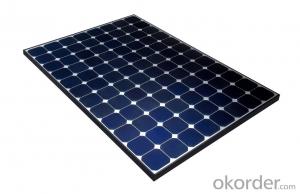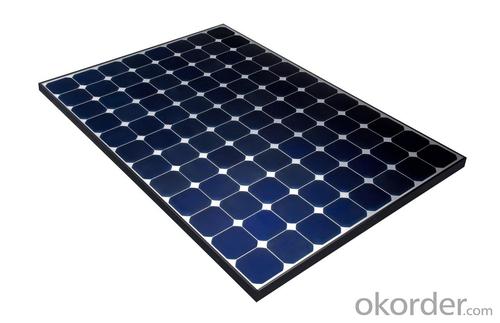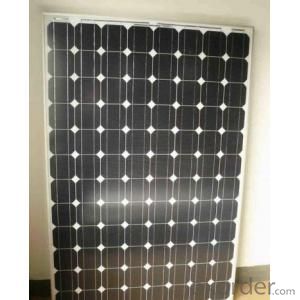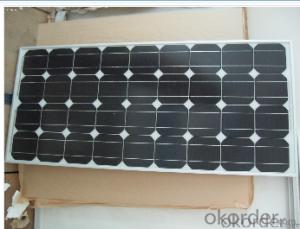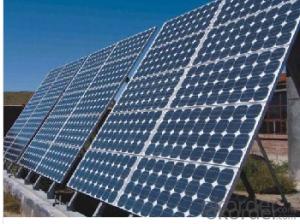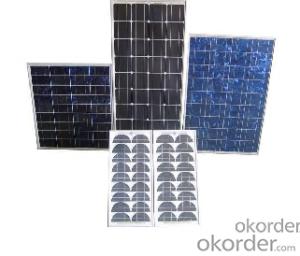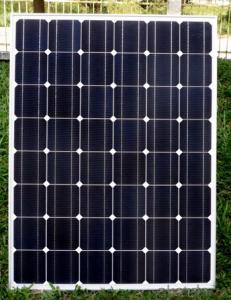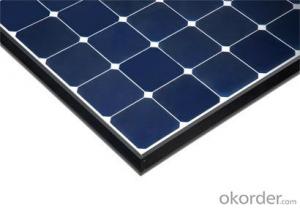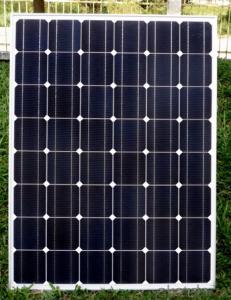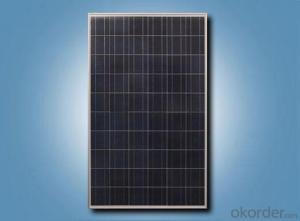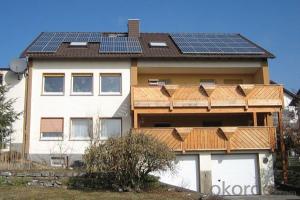Qcells A Grade Mono Solar Panel 300W - Cheapest Price
- Loading Port:
- Shanghai
- Payment Terms:
- TT OR LC
- Min Order Qty:
- 50 watt
- Supply Capability:
- 50000 watt/month
OKorder Service Pledge
OKorder Financial Service
You Might Also Like
Specification
Mono Solar Panel 260W A Grade with Cheapest Price
Product description
60 cell multi-crystalline solar module. 40mm natural anodised frame. IP65 rated Jbox, 1m solar cable and a pair of MC4 connectors.TÜV SÜD,SABS ISO 9001:2008 certified.
Several companies have begun embedding electronics into PV modules. This enables performing maximum power point tracking (MPPT) for each module individually, and the measurement of performance data for monitoring and fault detection at module level. Some of these solutions make use of power optimizers, a DC-to-DC converter technology developed to maximize the power harvest from solar photovoltaic systems. As of about 2010, such electronics can also compensate for shading effects, wherein a shadow falling across a section of a module causes the electrical output of one or more strings of cells in the module to fall to zero, but not having the output of the entire module fall to zero.
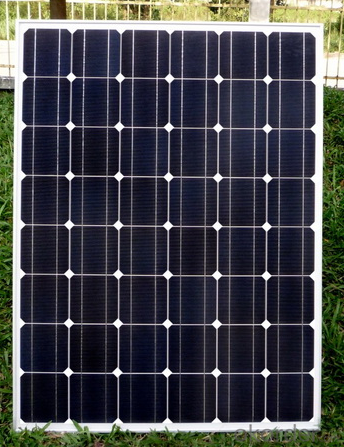
Application
Industrial
Commercial
Residential
Product feather
solar panel refers to a panel designed to absorb the sun's rays as a source of energy for generating electricity or heating.
A photovoltaic (in short PV) module is a packaged, connected assembly of typically 6×10 solar cells. Solar Photovoltaic panels constitute the solar array of a photovoltaic system that generates and supplies solar electricityin commercial and residential applications. Each module is rated by its DC output power under standard test conditions, and typically ranges from 100 to 365 watts. The efficiency of a module determines the area of a module given the same rated output – an 8% efficient 230 watt module will have twice the area of a 16% efficient 230 watt module. There are a few solar panels available that are exceeding 19% efficiency. A single solar module can produce only a limited amount of power; most installations contain multiple modules. A photovoltaic system typically includes a panel or an array of solar modules, a solar inverter, and sometimes a battery and/or solar tracker and interconnection wiring.
Packaging
24-26pcs into carton 312pcs for 20 foot container 712pcs for 40 foot container.
- Q: How do solar panels affect wildlife?
- Solar panels can have both positive and negative impacts on wildlife. On one hand, they can provide shade and shelter for certain species, promoting biodiversity. Additionally, solar farms can be designed to have minimal impact on local ecosystems, preserving habitats and reducing fragmentation. On the other hand, large-scale solar installations may disrupt natural habitats during construction and operation phases, potentially causing displacement or disturbance to some wildlife species. It is crucial to carefully plan and manage solar projects to minimize any negative effects and ensure coexistence with wildlife.
- Q: Can solar panels be installed on water treatment plants or utilities?
- Yes, solar panels can be installed on water treatment plants or utilities. In fact, many water treatment plants and utilities are increasingly adopting solar power as a sustainable and cost-effective energy solution. Solar panels can be installed on rooftops, open fields, or even on floating platforms over water bodies, providing clean energy to power the operations of these facilities.
- Q: Is it really necessary to make solar panels that expensive?
- First Solar recently announced that their costs to produce panels dropped below $ per watt. I don't know how much of that is accounting tricks. Of course, that doesn't mean that they would sell panels for that price - any capitalistic company is expected to drive the price up to what the market will bear. Crystalline silicon panel producers are coming in at about $2.50/watt right now for the best of them. But again, the selling price is what the market will bear.
- Q: Can I make a solar panel at home?How to make it?
- The first link is a video on how to make solar cells from powdered donuts and tea. But you probably want to make solar panels from scrap solar cells. The second video is on how to make solar panels from scrap solar cells. You used to be able to get damaged cells for free but so many people have been piecing them together that they sell them now. You've kinda missed the boat on solar panels for work alone.
- Q: Can solar panels be used in cloudy regions?
- Yes, solar panels can still be used in cloudy regions. While solar panels do work best under direct sunlight, they can still generate electricity from diffused or scattered sunlight present in cloudy conditions. However, the overall energy output may be lower compared to sunny regions.
- Q: How do solar panels affect roof aesthetics?
- Solar panels can have both positive and negative effects on roof aesthetics. On one hand, solar panels can enhance the look of a roof by providing a sleek and modern appearance, especially when integrated seamlessly into the roof design. On the other hand, some may argue that solar panels can detract from the overall aesthetic appeal of a roof, particularly if they are bulky or installed in a way that is visually obtrusive. However, with advances in solar panel technology, it is now possible to find more aesthetically pleasing options that blend well with different types of roofs, making them a viable option for homeowners concerned about both energy efficiency and the visual appeal of their roofs.
- Q: Can solar panels be used in areas with high levels of windstorms?
- Yes, solar panels can be used in areas with high levels of windstorms. However, it is important to ensure that the solar panels are properly installed and secured to withstand the strong winds. Additional measures such as reinforced mounting structures and regular maintenance can also be taken to enhance their durability in such conditions.
- Q: i have a fountain system that has a small electric pump. its made to be close to a house but i want it across the driveway and i dont want to run electrical over there.is there a small solar panel that i can get fairly inexpensive to mount on a nearby tree and be able to plug the pump into it?
- More okorder /... (... or search portable solar panel) And probably under a tree isn't a good placement for a solar panel. Good luck!
- Q: Are there any government incentives for installing solar panels?
- Yes, there are several government incentives for installing solar panels. These incentives can vary depending on the country and region, but they often include tax credits, grants, and subsidies. Additionally, some governments may offer net metering programs that allow solar panel owners to sell excess electricity back to the grid, further reducing their energy costs.
- Q: I don't see much solar panels on people's houses where I live. I got a long time to go before doing so but I was planning on buying a few solar panels when I retire in the far future. In your opinion, is such an investment worth it? Would you buy them? I realize they are very expensive hence why I said when I retire. Thanks for your opinion
- The payback is usually between about 5 and 5 years depending on how expensive electricity is in your area, the rebates available, and where you live (is it sunny most of the time?) Most people that get them don't do it for the investment - they do it to be energy responsible - but it's not a bad way to do both if you have the money to put into it. I personally just pay for the green energy option from my electricity provider. So I am buying power from solar and wind farms, and it cost about 0% more per month. I don't get the benefit of free power, but it comes with a smaller price tag initially, and I think when we all invest in these technologies, the price will improve over time, so energy costs will be lower in the future.
Send your message to us
Qcells A Grade Mono Solar Panel 300W - Cheapest Price
- Loading Port:
- Shanghai
- Payment Terms:
- TT OR LC
- Min Order Qty:
- 50 watt
- Supply Capability:
- 50000 watt/month
OKorder Service Pledge
OKorder Financial Service
Similar products
Hot products
Hot Searches
Related keywords
